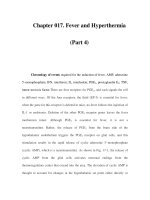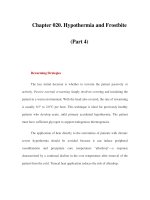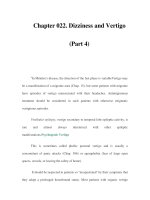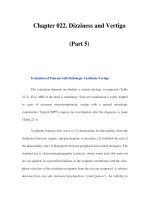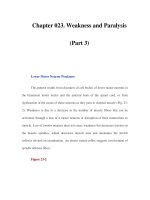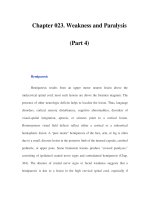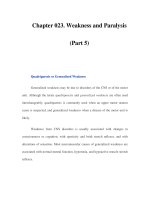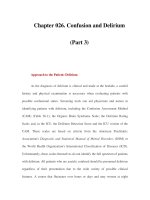Chapter 046. Sodium and Water (Part 4) ppt
Bạn đang xem bản rút gọn của tài liệu. Xem và tải ngay bản đầy đủ của tài liệu tại đây (14.69 KB, 5 trang )
Chapter 046. Sodium and Water
(Part 4)
Extrarenal
Nonrenal causes of hypovolemia include fluid loss from the gastrointestinal
tract, skin, and respiratory system and third-space accumulations (burns,
pancreatitis, peritonitis). Approximately 9 L of fluid enters the gastrointestinal
tract daily, 2 L by ingestion and 7 L by secretion. Almost 98% of this volume is
reabsorbed so that fecal fluid loss is only 100–200 mL/d. Impaired gastrointestinal
reabsorption or enhanced secretion leads to volume depletion. Since gastric
secretions have a low pH (high H
+
concentration) and biliary, pancreatic, and
intestinal secretions are alkaline (high HCO
3
–
concentration), vomiting and
diarrhea are often accompanied by metabolic alkalosis and acidosis, respectively.
Water evaporation from the skin and respiratory tract contributes to
thermoregulation. These insensible losses amount to 500 mL/d. During febrile
illnesses, prolonged heat exposure, exercise, or increased salt and water loss from
skin, in the form of sweat, can be significant and lead to volume depletion. The
Na
+
concentration of sweat is normally 20–50 mmol/L and decreases with profuse
sweating due to the action of aldosterone. Since sweat is hypotonic, the loss of
water exceeds that of Na
+
. The water deficit is minimized by enhanced thirst.
Nevertheless, ongoing Na
+
loss is manifest as hypovolemia. Enhanced evaporative
water loss from the respiratory tract may be associated with hyperventilation,
especially in mechanically ventilated febrile patients.
Certain conditions lead to fluid sequestration in a third space. This
compartment is extracellular but is not in equilibrium with either the ECF or the
ICF. The fluid is effectively lost from the ECF and can result in hypovolemia.
Examples include the bowel lumen in gastrointestinal obstruction, subcutaneous
tissues in severe burns, retroperitoneal space in acute pancreatitis, and peritoneal
cavity in peritonitis. Finally, severe hemorrhage from any source can result in
volume depletion.
Pathophysiology
ECF volume contraction is manifest as a decreased plasma volume and
hypotension. Hypotension is due to decreased venous return (preload) and
diminished cardiac output; it triggers baroreceptors in the carotid sinus and aortic
arch and leads to activation of the sympathetic nervous system and the renin-
angiotensin system. The net effect is to maintain mean arterial pressure and
cerebral and coronary perfusion. In contrast to the cardiovascular response, the
renal response is aimed at restoring the ECF volume by decreasing the GFR and
filtered load of Na
+
and, most importantly, by promoting tubular reabsorption of
Na
+
. Increased sympathetic tone increases proximal tubular Na
+
reabsorption and
decreases GFR by causing preferential afferent arteriolar vasoconstriction. Sodium
is also reabsorbed in the proximal convoluted tubule in response to increased
angiotensin II and altered peritubular capillary hemodynamics (decreased
hydraulic and increased oncotic pressure). Enhanced reabsorption of Na
+
by the
collecting duct is an important component of the renal adaptation to ECF volume
contraction. This occurs in response to increased aldosterone and AVP secretion
and suppressed atrial natriuretic peptide secretion.
Clinical Features
A careful history is often helpful in determining the etiology of ECF
volume contraction (e.g., vomiting, diarrhea, polyuria, diaphoresis). Most
symptoms are nonspecific and secondary to electrolyte imbalances and tissue
hypoperfusion and include fatigue, weakness, muscle cramps, thirst, and postural
dizziness. More severe degrees of volume contraction can lead to end-organ
ischemia manifest as oliguria, cyanosis, abdominal and chest pain, and confusion
or obtundation. Diminished skin turgor and dry oral mucous membranes are poor
markers of decreased interstitial fluid. Signs of intravascular volume contraction
include decreased jugular venous pressure, postural hypotension, and postural
tachycardia. Larger and more acute fluid losses lead to hypovolemic shock,
manifest as hypotension, tachycardia, peripheral vasoconstriction, and
hypoperfusion—cyanosis, cold and clammy extremities, oliguria, and altered
mental status.
Diagnosis
A thorough history and physical examination are generally sufficient to
diagnose the etiology of hypovolemia. Laboratory data usually confirm and
support the clinical diagnosis. The blood urea nitrogen (BUN) and plasma
creatinine concentrations tend to be elevated, reflecting a decreased GFR.
Normally, the BUN:creatinine ratio is about 10:1. However, in prerenal azotemia,
hypovolemia leads to increased urea reabsorption, a proportionately greater
elevation in BUN than plasma creatinine, and a BUN:creatinine ratio of 20:1 or
higher. An increased BUN (relative to creatinine) may also be due to increased
urea production that occurs with hyperalimentation (high-protein), glucocorticoid
therapy, and gastrointestinal bleeding.
The appropriate response to hypovolemia is enhanced renal Na
+
and water
reabsorption, which is reflected in the urine composition. Therefore, the urine Na
+
concentration should usually be <20 mmol/L except in conditions associated with
impaired Na
+
reabsorption, as in acute tubular necrosis (Chap. 273). Another
exception is hypovolemia due to vomiting, since the associated metabolic alkalosis
and increased filtered HCO
3
–
impair proximal Na
+
reabsorption. In this case, the
urine Cl
–
is low (<20 mmol/L). The urine osmolality and specific gravity in
hypovolemic subjects are generally >450 mosmol/kg and 1.015, respectively,
reflecting the presence of enhanced AVP secretion. However, in hypovolemia due
to diabetes insipidus, urine osmolality and specific gravity are indicative of
inappropriately dilute urine.
